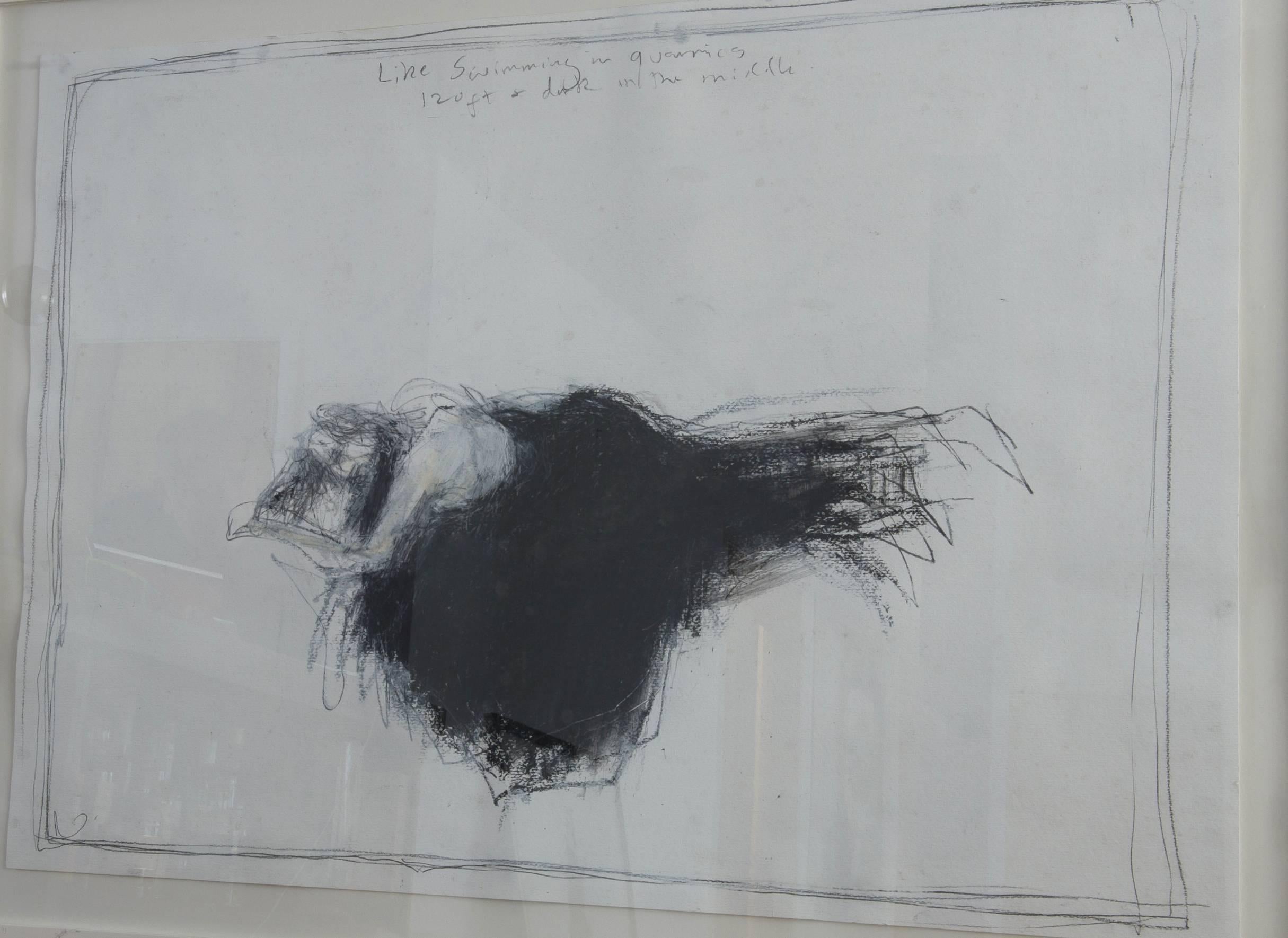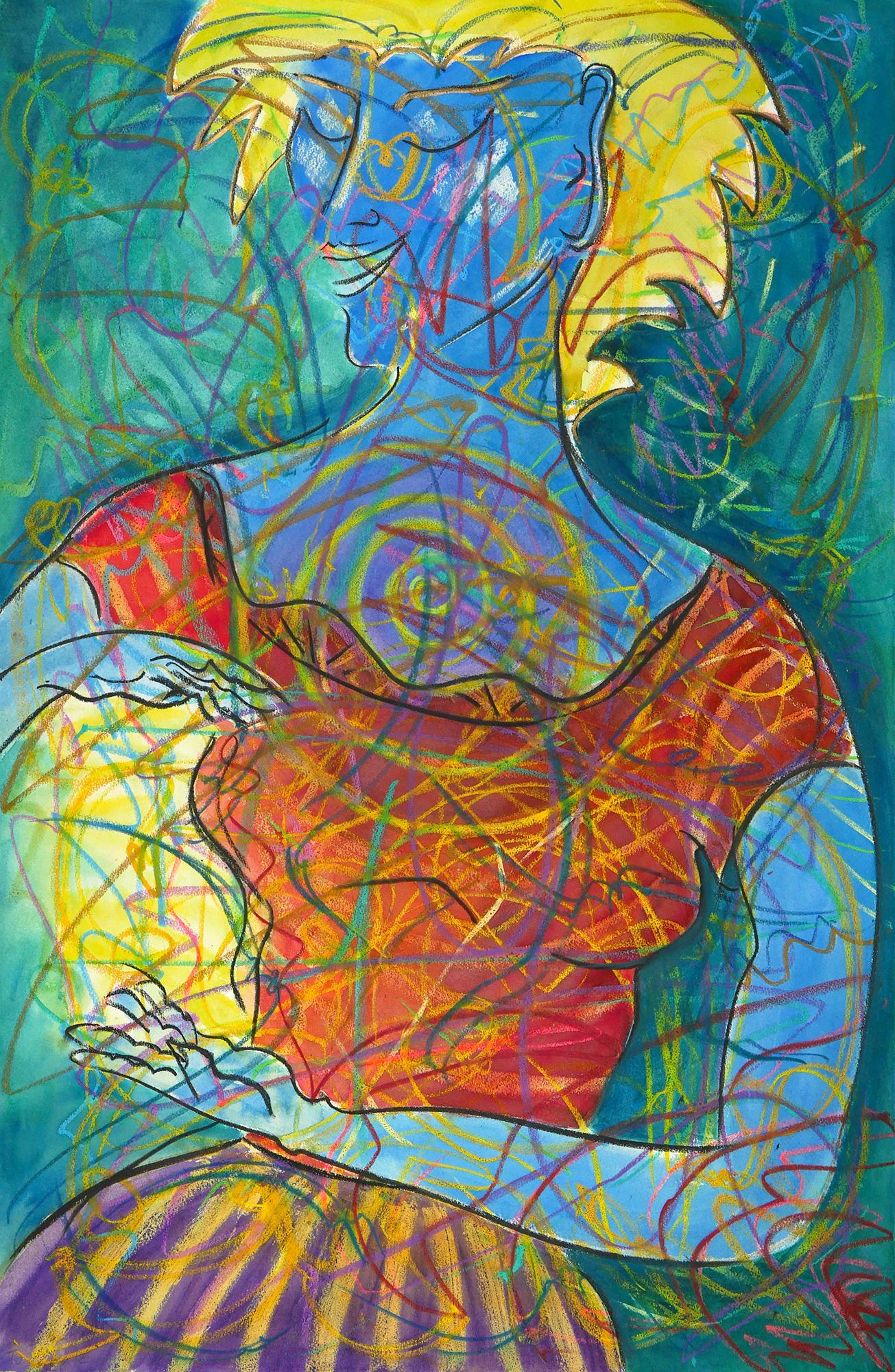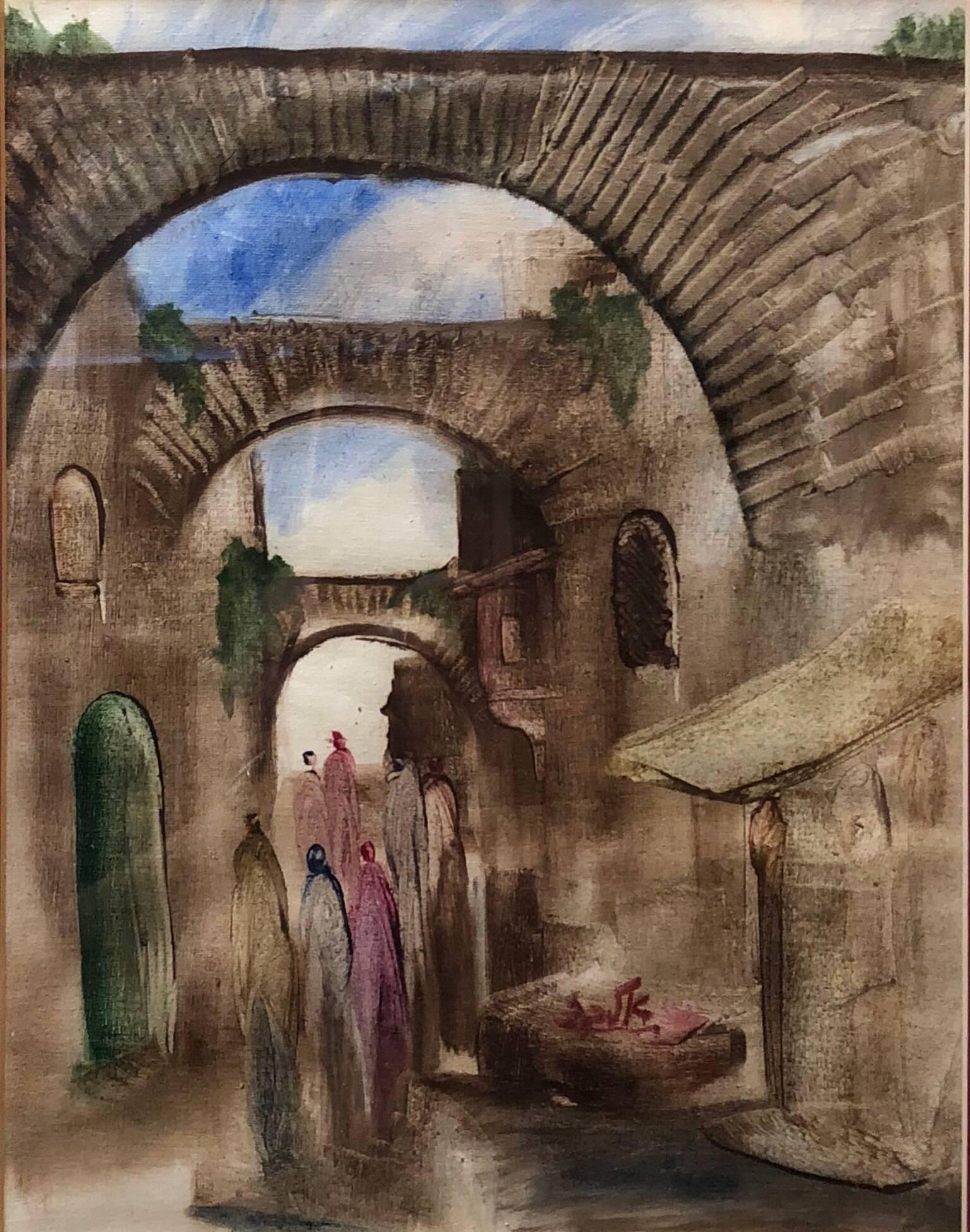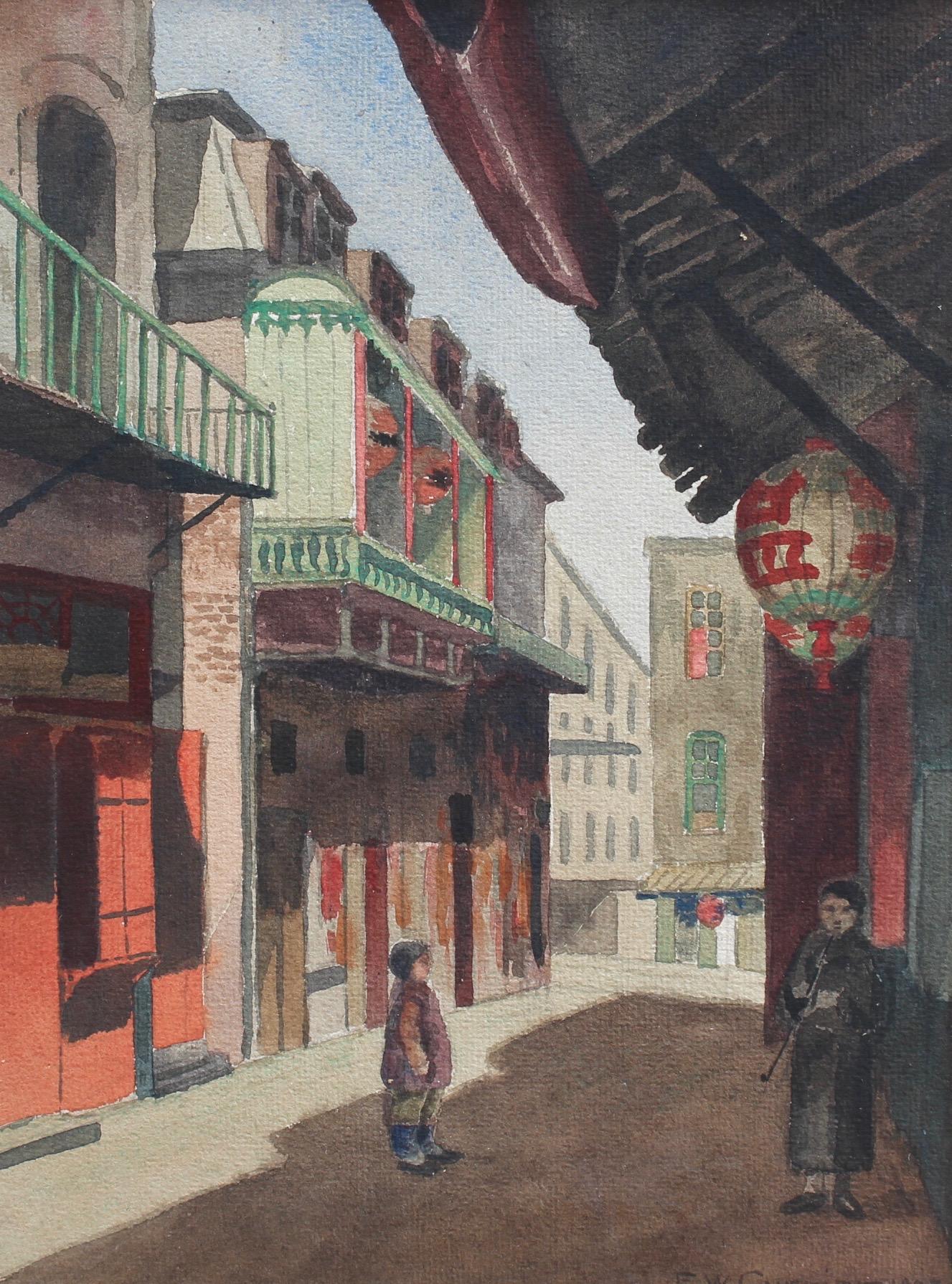Items Similar to Original German Expressionist Drawing Ernst Ludwig Kirchner Women Dancing
Want more images or videos?
Request additional images or videos from the seller
1 of 22
Original German Expressionist Drawing Ernst Ludwig Kirchner Women Dancing c.1905-1915
c.1905-1915
About the Item
Ernst Ludwig Kirchner ( Germany 1880-1938 )
Expressionist Female Women Dancing Mixed Media on Paper Drawing or Painting Expressionism
Dimensions: 20" L 16" H in
This bore a sticker from Christies auction house and another collection sticker verso but they have been inadvertently removed. I do have the photo.
Ernst Ludwig Kirchner (1880 – 1938) was a German expressionist painter and printmaker and one of the founders of the artists group Die Brücke or "The Bridge", a key group leading to the foundation of Expressionism in 20th-century art. He volunteered for army service in the First World War, but soon suffered a breakdown and was discharged. His work was branded as "Entartete Kunst" or "degenerate" by the Nazis in 1933, and in 1937 more than 600 of his works were sold or destroyed.
Ernst Ludwig Kirchner was born in Aschaffenburg, Bavaria. His parents were of Prussian descent and his mother was a descendant of the Huguenots, a fact to which Kirchner often referred. As Kirchner's father searched for a job, the family moved frequently and Kirchner attended schools in Frankfurt and Perlen until his father earned the position of Professor of Paper Sciences at the College of technology in Chemnitz, where Kirchner attended secondary school. Although Kirchner's parents encouraged his artistic career they also wanted him to complete his formal education so in 1901, he began studying architecture at the Königliche Technische Hochschule (royal technical university) of Dresden. The institution provided a wide range of studies in addition to architecture, such as freehand drawing, perspective drawing and the historical study of art. While in attendance, he became close friends with Fritz Bleyl, whom Kirchner met during the first term. They discussed art together and also studied nature, having a radical outlook in common. Kirchner continued studies in Munich from 1903 to 1904, returning to Dresden in 1905 to complete his degree.
In 1905, Kirchner, along with Bleyl and two other architecture students, Karl Schmidt-Rottluff and Erich Heckel, founded the artists group Die Brücke ("The Bridge") later to include Emil Nolde, Max Pechstein and Otto Mueller. From then on, he committed himself to art. The group aimed to eschew the prevalent traditional academic style and find a new mode of artistic expression, which would form a bridge (hence the name) between the past and the present. They responded both to past artists such as Albrecht Dürer, Matthias Grünewald and Lucas Cranach the Elder, as well as contemporary international avant-garde movements. As part of the affirmation of their national heritage, they revived older media, particularly woodcut or woodblock prints.
Kirchner's studio became a venue which overthrew social conventions to allow casual love-making and frequent nudity. Group life-drawing sessions took place using nude models from the social circle, rather than professionals, and choosing quarter-hour poses to encourage spontaneity. In 1911, he moved to Berlin, where he founded a private art school, MIUM-Institut, in collaboration with Max Pechstein with the aim of promulgating "Moderner Unterricht im Malen" (modern teaching of painting). This was not a success and closed the following year, when he also began a relationship with Erna Schilling that lasted the rest of his life. In 1917, at the suggestion of Eberhard Grisebach [de], Helene Spengler invited Kirchner to Davos where he viewed an exhibition of Ferdinand Hodler paintings. "When I was leaving, I thought of Vincent Van Gogh's fate and thought that it would be his as well, sooner or later. Only later will people understand and see how much he has contributed to painting".
In 1921 Kirchner visited Zurich at the beginning of May and met the dancer, Nina Hard, whom he invited back to Frauenkirch (despite Erna's objections). Nina Hard would become an important model for Kirchner and would be featured in many of his works. Kirchner began creating designs for carpets which were then woven by Lise Gujer.
In 1925, Kirchner became close friends with fellow artist, Albert Müller and his family. Rot-Blau, a new art group based in Basel, was formed by Hermann Scherer, Albert Müller, Paul Camenisch and Hans Schiess, who all visited Kirchner and worked under his guidance. At the end of 1925, Kirchner returned to Germany and made his rounds to Frankfurt, Chemnitz (where his mother was living), and Berlin where he met with Karl Schmidt-Rottluff who wanted Kirchner to form a new artist's group; Kirchner politely refused. Kirchner continued to work in Frauenkirch, his style growing increasingly abstract. In 1931, he was made a member of the Prussian Academy of Arts in Berlin. As the Nazi party took power in Germany, it became impossible for Kirchner to sell his paintings. In 1937, he was forced to resign from the Prussian Academy of Arts. Kirchner became increasingly disturbed by the situation in Germany, writing: "Here we have been hearing terrible rumours about torture of the Jews, but it's all surely untrue. I'm a little tired and sad about the situation up there. There is a war in the air. In the museums, the hard-won cultural achievements of the last 20 years are being destroyed, and yet the reason why we founded the Brücke was to encourage truly German art, made in Germany. And now it is supposed to be un-German. Dear God. It does upset me".
In 1934, Kirchner visited Berne and Zurich, finding the former more pleasing than the latter, and met Paul Klee. In the winter of 1935, a new school was being planned to be built in Frauenkirch and Kirchner offered to paint a mural. In 1913, the first public showing in the United States of Kirchner's work took place at the Armory Show, which was also the first major display of modern art in America. In 1921, U.S. museums began to acquire his work and did so increasingly thereafter. His first solo museum show in the US was at the Detroit Institute of Arts in 1937.[ In 1969, a major retrospective of paintings, drawings, and prints traveled to the Seattle Art Museum, the Pasadena Art Museum, and the Museum of Fine Arts, Boston. In 1992, the National Gallery of Art, Washington, held a monographic show, using its existing collection; a major international loan exhibition took place in 2003. In November 2006 at Christie's, Kirchner's Street Scene, Berlin (1913) fetched $38 million, a record for the artist. From 3 August to 10 November 2008, the Museum of Modern Art in New York held a major exhibition that "probably comprises the very best of his oeuvre."
Many of Kirchner's collectors were Jewish and persecuted by the Nazis for that reason. They either sold off their collections in order to flee the Nazis or had their collections seized. The Kirchner paintings "Berlin Street Scene" and "Judgement of Paris" were owned by the Jewish art collector Alfred Hess whose widow was forced to relinquish them before fleeing. Kirchner's 1915 painting Artillerymen was owned by the important art dealer of modern art, the German Jewish Alfred Flechtheim whose art gallery was Aryanized (seized by Nazis) in 1933 before he fled Germany. Kirchner's painting Sand Hills in Engadine, which had been seized by the Nazis in 1935 after its owner, Max Fischer, fled Germany for the United States, found its way into the collection of the MoMA, but was returned to Fischer's heirs in 2015. His monumental Bathers (1916), destroyed by the Nazis, has been re-created at the Kirchner Museum in Davos.
- Attributed to:Ernst Ludwig Kirchner (1880-1938, German)
- Creation Year:c.1905-1915
- Dimensions:Height: 16 in (40.64 cm)Width: 20 in (50.8 cm)
- Medium:
- Movement & Style:
- Period:
- Condition:Please see photos.
- Gallery Location:Surfside, FL
- Reference Number:1stDibs: LU38211932652
About the Seller
4.9
Platinum Seller
These expertly vetted sellers are 1stDibs' most experienced sellers and are rated highest by our customers.
Established in 1995
1stDibs seller since 2014
1,547 sales on 1stDibs
Typical response time: 1 hour
- ShippingRetrieving quote...Ships From: Surfside, FL
- Return PolicyA return for this item may be initiated within 3 days of delivery.
More From This SellerView All
- Jerusalem Old City Landscape, Expressionist Judaica Israeli PaintingBy Andre ElbazLocated in Surfside, FLIn this painting the artist uses gestural brushstrokes, which causes distortion and exaggeration for emotional effect. Andre Elbaz uses as his subject figures walking in old city Jerusalem. André Elbaz (born April 26, 1934, El Jadida, Morocco) is a famous Moroccan painter and filmmaker. Elbaz studied art and theatre in Rabat and Paris from 1950 to 1961. He started painting only at the age of 21, until which age he had been interested mainly in theatre. A few years later, he managed to combine his two passions into a new approach in art-therapy, inventing together with his wife, a psychiatrist, the Pictodrame, which brought him world recognition. His first exhibition, which was very successful, took place in Casablanca in 1961 and earned him an appointment as Professor at the Beaux-Arts school in Casablanca. Years later, in 1976, he exhibited his paintings at the Tel-Aviv Museum. In parallel to his career as a painter, Elbaz is also known as a filmmaker. He produced several short films in France, Canada and the United States. One of them, La nuit n'est jamais complète (The night is never complete), won a prize at the "5th Biennale de Paris in 1967". Among the themes chosen for the many films he produced, there was a short one about the Warsaw Ghetto uprising, as well as a series of drawings entitled Seuls (Alone), with texts written by both Elie Wiesel...Category
20th Century Expressionist Figurative Paintings
MaterialsPaper, Gouache
- Three Rabbis at The Torah, Expressionist Judaica PaintingBy Andre ElbazLocated in Surfside, FLIn this painting the artist uses gestural brushstrokes, which causes distortion and exaggeration for emotional effect. Andre Elbaz uses as his subject three male figures with tefilin are depicted during prayer. André Elbaz (born April 26, 1934, El Jadida, Morocco) is a famous Moroccan painter and filmmaker. Elbaz studied art and theatre in Rabat and Paris from 1950 to 1961. He started painting only at the age of 21, until which age he had been interested mainly in theatre. A few years later, he managed to combine his two passions into a new approach in art-therapy, inventing together with his wife, a psychiatrist, the Pictodrame, which brought him world recognition. His first exhibition, which was very successful, took place in Casablanca in 1961 and earned him an appointment as Professor at the Beaux-Arts school in Casablanca. Years later, in 1976, he exhibited his paintings at the Tel-Aviv Museum. In parallel to his career as a painter, Elbaz is also known as a filmmaker. He produced several short films in France, Canada and the United States. One of them, La nuit n'est jamais complète (The night is never complete), won a prize at the "5th Biennale de Paris in 1967". Among the themes chosen for the many films he produced, there was a short one about the Warsaw Ghetto uprising, as well as a series of drawings entitled Seuls (Alone), with texts written by both Elie Wiesel...Category
20th Century Expressionist Figurative Paintings
MaterialsPaper, Gouache
- Jerusalem Old City Landscape, Expressionist Judaica Israeli Painting IIBy Andre ElbazLocated in Surfside, FLIn this painting the artist uses gestural brushstrokes, which causes distortion and exaggeration for emotional effect. Andre Elbaz uses as his subject figures walking in old city Jerusalem. André Elbaz (born April 26, 1934, El Jadida, Morocco) is a famous Moroccan painter and filmmaker. Elbaz studied art and theatre in Rabat and Paris from 1950 to 1961. He started painting only at the age of 21, until which age he had been interested mainly in theatre. A few years later, he managed to combine his two passions into a new approach in art-therapy, inventing together with his wife, a psychiatrist, the Pictodrame, which brought him world recognition. His first exhibition, which was very successful, took place in Casablanca in 1961 and earned him an appointment as Professor at the Beaux-Arts school in Casablanca. Years later, in 1976, he exhibited his paintings at the Tel-Aviv Museum. In parallel to his career as a painter, Elbaz is also known as a filmmaker. He produced several short films in France, Canada and the United States. One of them, La nuit n'est jamais complète (The night is never complete), won a prize at the "5th Biennale de Paris in 1967". Among the themes chosen for the many films he produced, there was a short one about the Warsaw Ghetto uprising, as well as a series of drawings entitled Seuls (Alone), with texts written by both Elie Wiesel...Category
20th Century Expressionist Figurative Paintings
MaterialsGouache, Paper
- One More Time (Black Devil) Outsider Art Painting, DrawingBy Peter DeanLocated in Surfside, FLDean was born in 1934 of Jewish parents in a Berlin, Germany, that was falling prey to the Nazis. The family immigrated to New York City in 1938, and Dean was raised in the refugee community in Inwood. Dean's first show (ironically, in retrospect) was given him by the USIA in Brazil. In 1959, he returned to New York to work six months on, six months off in soil engineering and made art in the interims. He tried, and failed, to get into a Tenth Street Gallery. Studying painting at night with Andre Girard at City College pushed him over the edge, and in 1969 he committed himself to painting full time. Artists who impressed him in the '60s were Robert Beauchamp, Lester Johnson, Jan Muller...Category
1980s Expressionist Figurative Drawings and Watercolors
MaterialsPaper, Oil Pastel, Acrylic
- Modern Figurative Surrealism Watercolor Painting, Drawing 'Faces of Deceit'By Gary HansmannLocated in Surfside, FLOn heavy Arches deckle edged paper. This combines text or poetry in calligraphy on the side. Gary Hansmann (1947-2008) was active/lived in California. He is known for abstract, Surrealism figure painting. Gary William Hansmann was born Dec. 4, 1940, in San Diego to Ethel May Williams and Lester Hughes Hansmann. He grew up in Encinitas and served in the Army in the early 1960s. Gary Hansmann, San Diego artist, teacher and gallery owner, was known for his Surrealist nude and animal drawings and graphics. He spent time working in Paris and exhibiting his art throughout Europe, but San Diego was home until he moved to Washington state. His life partner was fellow artist, Jill Hosmer. Mr. Hansmann, a respected printmaker and prolific artist, created thousands of drawings, prints and paintings as well as hundreds of poems. His interest in bullfighting led to a book of poetry and illustrations on the subject, “La Corrida, The Run”, a collection of poetry & artwork written as he was preparing for his first bullfight. Prologue written by famous Mexican Matador Antonio Lomelin. The book is written in English and translated into Spanish on opposing pages and was published in 1983. Mr. Hansmann taught intaglio and monotype at the Academy of Fine Arts in San Diego from 1977 to 1980 and at the San Diego Museum of Art in 1980. He also gave lectures and demonstrations throughout the art community, including at the San Diego Art Guild in Del Mar and Artist Equity in San Diego. Although he attended Palomar College in San Marcos and studied lithography at the San Diego Academy of Fine Arts, Mr. Hansmann was mostly self-taught and self-educated. Mr. Hansmann had shows in several art-world capitals, including Paris; Lisbon, Portugal; Cologne, Germany; Brussels, Belgium; and New York. he had one-person exhibits at the Loft Gallery in Clarkston, the Lewis-Clark State College Center of Arts & History, the Carnegie Art Center in Walla Walla and the Valley Art Center in Clarkston. During his long, distinguished career as an artist he had numerous one-person exhibits all over the world and the United States. His group shows are too numerous to mention, but his one-person exhibits were in Koln, Germany; Bruxelles, Belgium; Paris, France; Viana do Castelo, Portugal; Lisbon, Portugal; Tecate, Mexico; and British Columbia, Canada; and many states at home. Palomar College, San Marcos, Calif. San Diego Academy of Fine Arts Brooklyn Museum, Brooklyn, N.Y. University of Southern California, Idyllwild (ISOMATA) University of San Diego San Diego Museum of Art James Copley Library, La Jolla, Calif. Biblioteca Nazionale Marciana, Venice, Italy Centre de Arte Moderna Gulbenkian Foundation, Lisbon, Portugal Museo Taurino de la Communidad de Madrid, Madrid, Spain Atelier Lacouriere et Frelaut, Paris, France Gordon Gilkey Collection Portland Art Museum, Portland, Or. Coos Art Museum, Coos Bay...Category
1980s Surrealist Figurative Paintings
MaterialsPaper, India Ink, Watercolor
- Modern Figurative Surrealism Watercolor Painting, Drawing 'The Fire of my Soul'By Gary HansmannLocated in Surfside, FLOn heavy Arches deckle edged paper. This combines text or poetry in calligraphy on the side. Gary Hansmann (1947-2008) was active/lived in California. He is known for abstract, Surrealism figure painting. Gary William Hansmann was born Dec. 4, 1940, in San Diego to Ethel May Williams and Lester Hughes Hansmann. He grew up in Encinitas and served in the Army in the early 1960s. Gary Hansmann, San Diego artist, teacher and gallery owner, was known for his Surrealist nude and animal drawings and graphics. He spent time working in Paris and exhibiting his art throughout Europe, but San Diego was home until he moved to Washington state. His life partner was fellow artist, Jill Hosmer. Mr. Hansmann, a respected printmaker and prolific artist, created thousands of drawings, prints and paintings as well as hundreds of poems. His interest in bullfighting led to a book of poetry and illustrations on the subject, “La Corrida, The Run”, a collection of poetry & artwork written as he was preparing for his first bullfight. Prologue written by famous Mexican Matador Antonio Lomelin. The book is written in English and translated into Spanish on opposing pages and was published in 1983. Mr. Hansmann taught intaglio and monotype at the Academy of Fine Arts in San Diego from 1977 to 1980 and at the San Diego Museum of Art in 1980. He also gave lectures and demonstrations throughout the art community, including at the San Diego Art Guild in Del Mar and Artist Equity in San Diego. Although he attended Palomar College in San Marcos and studied lithography at the San Diego Academy of Fine Arts, Mr. Hansmann was mostly self-taught and self-educated. Mr. Hansmann had shows in several art-world capitals, including Paris; Lisbon, Portugal; Cologne, Germany; Brussels, Belgium; and New York. he had one-person exhibits at the Loft Gallery in Clarkston, the Lewis-Clark State College Center of Arts & History, the Carnegie Art Center in Walla Walla and the Valley Art Center in Clarkston. During his long, distinguished career as an artist he had numerous one-person exhibits all over the world and the United States. His group shows are too numerous to mention, but his one-person exhibits were in Koln, Germany; Bruxelles, Belgium; Paris, France; Viana do Castelo, Portugal; Lisbon, Portugal; Tecate, Mexico; and British Columbia, Canada; and many states at home. Palomar College, San Marcos, Calif. San Diego Academy of Fine Arts Brooklyn Museum, Brooklyn, N.Y. University of Southern California, Idyllwild (ISOMATA) University of San Diego San Diego Museum of Art James Copley Library, La Jolla, Calif. Biblioteca Nazionale Marciana, Venice, Italy Centre de Arte Moderna Gulbenkian Foundation, Lisbon, Portugal Museo Taurino de la Communidad de Madrid, Madrid, Spain Atelier Lacouriere et Frelaut, Paris, France Gordon Gilkey Collection Portland Art Museum, Portland, Or. Coos Art Museum, Coos Bay...Category
1980s Surrealist Figurative Paintings
MaterialsPaper, India Ink, Watercolor
You May Also Like
- Like Swimming In A Quarry. Contemporary Figurative DrawingBy Paul WadsworthLocated in Brecon, PowysLike Swimming In A Quarry - 120 feet and dark in the middle. One of Wadsworth's celebrated & innovative Black Cloth series. His sitters pose with a large black cloth & talk about wha...Category
21st Century and Contemporary Expressionist Figurative Paintings
MaterialsInk, Watercolor, Graphite
- Holder of Light, Wild Woman Series, bright color blue yellowBy Janet MorganLocated in Brooklyn, NYThis painting is in a series called the Wild Woman which is also printed in a pocket sized book. Watercolor, mixed media, using resists. Janet Morgan’s...Category
2010s Expressionist Figurative Drawings and Watercolors
MaterialsMixed Media, Watercolor, Archival Paper
- Expressionist Gouache and Watercolour Study for 'Alexander and His Army'Located in Cotignac, FRFrench late 20th century watercolour and gouache study for the series 'Alexander and His Army' by Stephane Lovighi-Bourgogne. Presented in plain wood frame. A strong and forceful de...Category
Late 20th Century Expressionist Figurative Drawings and Watercolors
MaterialsPaper, Watercolor, Gouache
- Chinatown, San FranciscoBy Edward Wilson CurrierLocated in London, GB'Chinatown, San Francisco', gouache on fine art paper, by Edward Wilson Currier (1903). Spofford Alley in San Francisco's Chinatown is best known for an address (number 36) where Dr. Sun Yat-Sen plotted the overthrow of China's last dynasty. During Prohibition, it was the site of turf battles over local bootlegging and protection rackets. Today it is lined with seniors' community centres. However, the quiet alley livens up in the evenings when a Chinese orchestra strikes up a tune, mah-jongg games begin with a cascade of clicking tiles, and barbers and florists use the pretence of sweeping their doorsteps to gossip. In this artist's depiction, a man smokes a long-stemmed Chinese pipe under the awning and colourful lanterns hanging from the wooden supports while a child looks on. The artwork is interesting from several standpoints including architectural, cultural and historical. Shortly after this work was painted, the neighbourhood was completely destroyed in the 1906 earthquake that levelled most of the city. From 1910 to 1940, Chinese immigrants were detained at the Angel Island...Category
Early 1900s Expressionist Figurative Drawings and Watercolors
MaterialsGouache, Paper
- Church of Saint-Nicolas du Chardonnet in ParisBy Lucien GéninLocated in London, GB'The Church of Saint-Nicolas du Chardonnet, Paris', gouache on art paper by Lucien Génin (circa 1930s). In Paris' 5th Arrondissement the site in which Saint-Nicolas du Chardonnet is ...Category
1930s Expressionist Figurative Paintings
MaterialsPaper, Gouache
- Emile's TavernBy Lucien GéninLocated in London, GB'Emile's Tavern', gouache on paper (circa 1930s), by Lucien Génin. A tavern in French is called a 'guinguette'. With the rise in living standards from the 1860s along with the develo...Category
1930s Expressionist Figurative Paintings
MaterialsPaper, Gouache
Recently Viewed
View AllMore Ways To Browse
Middle Eastern Girl
Dior Schuhe
Ego Italiano
Reginald K Gee Pastel
The Smiths Poster
Abstract Hard Impasto Painting
Russian Communist Art
Women Arabia
Butterfly Effect
Small Pastoral Landscape
Grey Smith
Modernist Bauhaus Painting
Cartier Pass
Antique Scottish School
Philip Sites
Palm Beach Bird
Couple Embrace Love
Record Organizer





